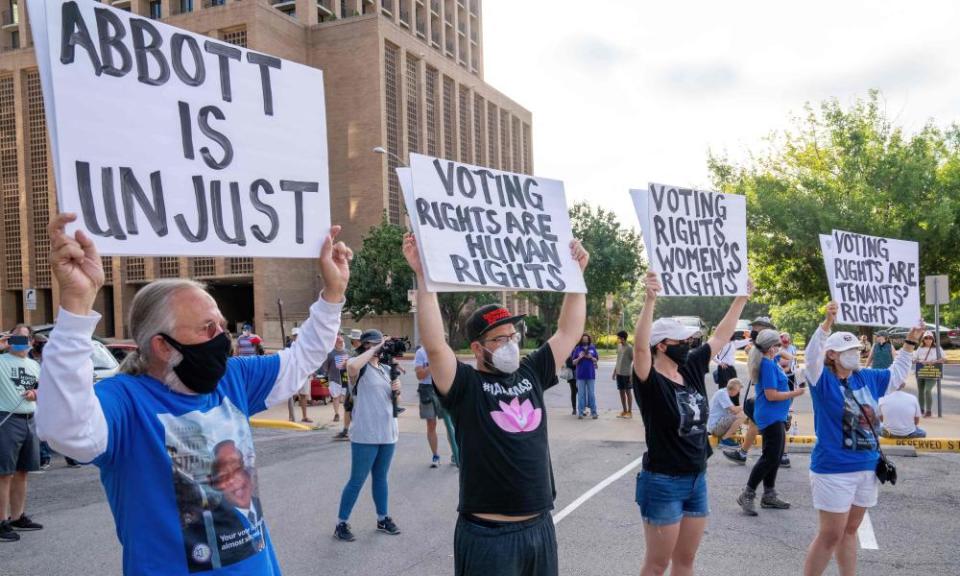How Texas Republicans are rigging the system against minority voters

Hello Fight to vote readers,
You don’t have to be an expert to see why Texas’ new maps for its state legislature and congress discriminate against minority voters. Ninety-five per cent of the state’s growth over the last decade has been driven by minorities. But the new maps Texas enacted don’t include a single new district where there is a Hispanic majority.
It’s an astounding fact that underscores how powerfully Texas Republicans have wielded the control they have over the once-a-decade redistricting process.
Republicans currently have a 23-13 advantage over Democrats in the congressional delegation, and the new map gives them a good chance to pick up the two extra seats.
The boundaries of several of the congressional districts Donald Trump barely won in 2020 have become safe GOP seats. I wrote about one of those districts, the 22nd congressional district a few weeks ago. The new map transforms it from one Trump won by about 1 percentage point in 2020 to one he would have carried by 16 points.
A few days before the Texas governor, Greg Abbott, approved the maps, I spoke with Nina Perales, a lawyer at the Mexican American Legal Defense Fund (Maldef), who filed the first of two lawsuits challenging the maps, and who is one of the most widely respected redistricting attorneys in the country. I asked her to walk me through how exactly Texas Republicans had gone about entrenching control and what might happen next.
“These maps are intended to protect incumbents against the effects of demographic change,” said Perales, who has been involved in Texas redistricting cases for decades. “They’re also maps to kind of protect white voters and the power of white voters at the expense of clearly Latino voters, because Latinos are the large demographic that’s growing very quickly.”
Of the two new seats, “one is made into a white majority Republican seat. And the other one is made into a white-majority Democratic seat. So white people win and people of color don’t get anything,” she added.
Texas has a long history of discriminating against minority voters in redistricting – courts have struck down districts in every redistricting cycle since the Voting Rights Act was enacted in 1965. For years a key provision of the act required Texas to get its maps pre-approved by the federal government before they went into effect. But the US supreme court gutted that provision in 2013. That means this year will be the first time since 1965 that Texas won’t have to get its maps pre-cleared before they go into effect.
That puts Perales and other people challenging the maps at a huge disadvantage. One reason is that the burden now falls on those who challenge the map to demonstrate why districts are discriminatory. Before, the burden was on Texas to show why the maps didn’t discriminate.
“Essentially, we have to prove race discrimination. That’s very hard to prove. The working assumption is always going to be that the state did not discriminate. And it’s our burden to establish that the state did discriminate. And courts are just very, very reluctant to accept the idea that a state actor has discriminated on the basis of race, even unintentionally.”
The new Texas districts should be the poster child that show why pre-clearance is still needed, Perales said. Given clear evidence of recent discrimination in redistricting, Texas should have a burden to show why the new plans don’t discriminate, Perales said.
Yet as they were drawing the districts, Republicans were already building a shield against claims that the maps were drawn with race in mind. “I’ve stated it, and I’ll state it again – we drew these maps race blind,” Joan Huffman, the GOP state senator, who oversaw the redistricting process in her chamber said during a public hearing.
Perales said that kind of claim was “a lie”.
“Do you think she was blind to the fact that the Rio Grande Valley is heavily Hispanic? Or the border region is heavily Hispanic? Do you think the historic wards of Houston, historic Black neighborhoods, that she’s somehow unaware of those things? It’s just not true,” she said.
When she testified at one of the legislature’s redistricting hearings, Perales urged lawmakers not to repeat the mistakes of the past. Afterwards she realized she had said something nearly identical during the redistricting cycle 10 years ago.
“I feel almost cursed,” she said. “I go to these hearings. I tell them about the cases that they’ve lost. I tell them not to repeat the mistakes. I tell them the plans are likely illegal. And they go ahead and do it anyway.”
Reader questions
Thank you to everyone who wrote in last week with questions. You can continue to write to me each week at sam.levine@theguardian.com or DM me on Twitter at @srl and I’ll try and answer as many as I can.
Andy in Washington writes: Are there mechanisms that can be put into place to help reduce lawsuits (such as those impacting election law) that have no sound basis before they drag through the courts? Asking this because we all watched as the Trump team put the legal system to task claiming election fraud, and lost over 50 of these cases. It was clear to most rational people what was going on, yet our legal system allowed this continuance of abuse of power to great detriment.
Yes, there are mechanisms in place that are supposed to hold bad-faith actors accountable in the legal system.
In August, a federal judge in Detroit sanctioned Sidney Powell and L Lin Wood, two attorneys involved in several of Trump’s post-election suits, for making bad-faith arguments. Powell and Wood were ordered to take legal education classes and pay attorneys fees to the city of Detroit and the state of Michigan. Rudy Giuliani also had his law license suspended in New York and Washington DC for spreading election lies.

 Yahoo News
Yahoo News 